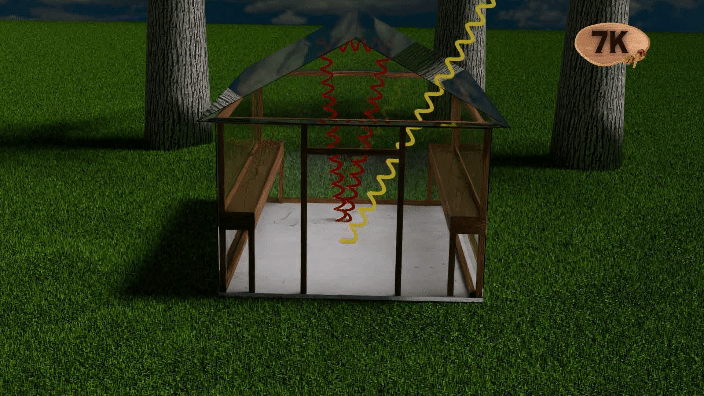The Greenhouse Effect. THIS IS NOT A BLOG ABOUT CLIMATE CHANGE.
Ever find yourself marveling at the simplicity of a sunny day while seated comfortably behind a pane of glass? There’s a fascinating interplay of light at work, one that warms your face without warming the air around you. This phenomenon, familiar yet often unexplored, shares its principles with the grand-scale process that keeps our Earth at the perfect temperature for life as we know it: the greenhouse effect.
Imagine the sun as a generous giver of visible light waves, pouring energy across the cosmos toward Earth. This light, largely unimpeded by our atmosphere, reaches the ground, warming it. Now, here’s where the magic happens: the Earth, in turn, radiates energy back into the atmosphere, but not in the form of visible light. This energy is infrared radiation, a type of light we can feel as heat but cannot see. Take a look at the 2 images below. In this experiment the images were both taken with the same infrared camera. The camera did not move and the subject did not move. The only change is a piece of glass was placed between the IR camera and the subject. In the picture on the left we see the heat radiating off of my son in the form of infrared radiation. On the right we see the reflection of the heat radiating off of me.

You’ve likely noticed that a greenhouse—or your car on a sunny day—gets warmer inside, even though it’s made of glass. Glass allows sunlight’s visible rays to enter with ease but is less accommodating to infrared radiation trying to exit. Instead of passing through, much of this infrared radiation is reflected back, trapping warmth inside.

This interplay is akin to what occurs on a global scale in our atmosphere. Certain gases in our atmosphere, including water vapor, carbon dioxide, and methane, act much like the glass of a greenhouse, letting sunlight in but making it harder for the heat to escape. The Earth’s surface warms up, radiates infrared energy back toward the sky, and these gases, often called “greenhouse gases,” reflect some of this heat back to the Earth instead of letting it escape into space.

This natural blanket is why our planet can sustain life, keeping temperatures at a hospitable level. Without this natural greenhouse effect, Earth’s average temperature would be about 0°F(-18°C), far too cold for most life forms currently thriving.
But how does this compare to our everyday experience with glass? When light hits a glass window, visible light passes through but infrared radiation, generated by objects inside (like a plant or a cozy reading nook), finds a harder time escaping. This is because glass, much like greenhouse gases, has a selective transmission ability—it discriminates between different forms of light. This property ensures that while light enters, heat is less able to leave, creating a warmer environment inside without any additional heating source.
In essence, the greenhouse effect on a planetary scale and the warming effect you feel behind a glass window are two sides of the same coin. Both involve the selective passage of light and the reflection of infrared radiation, leading to a warming effect. This principle is pivotal, not only in understanding how our planet maintains its delicate balance of temperatures but also in appreciating the everyday occurrences that mirror these global processes.
As we go about our days, let’s take a moment to appreciate the science behind the scenes—from the warmth of sunlight through a window to the life-sustaining balance of the greenhouse effect. These processes, grand and minute, remind us of the intricate systems at play, making our world habitable and our moments in the sun delightfully warm.
#greenhouseeffect
#science
#greenhouse
